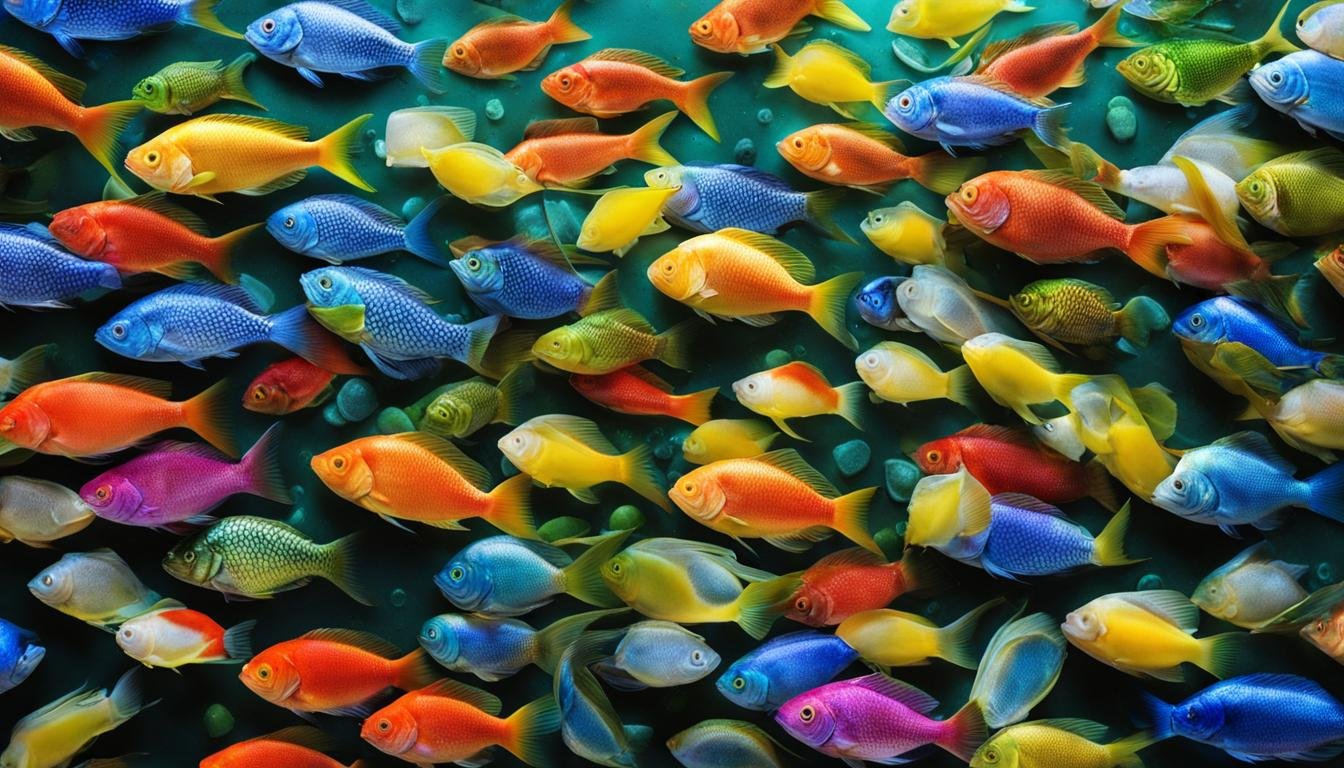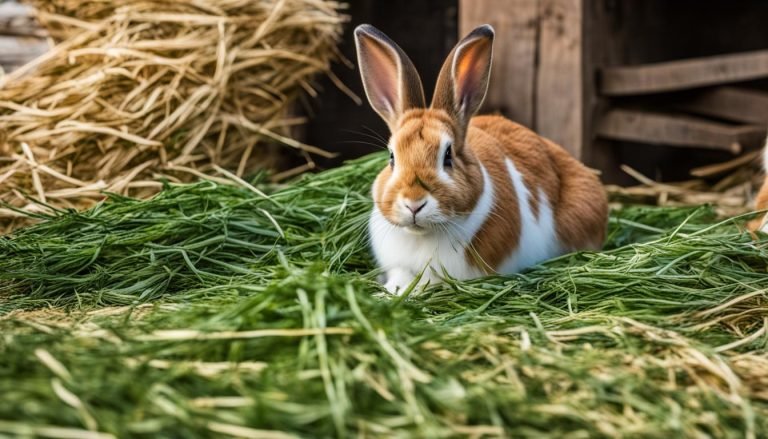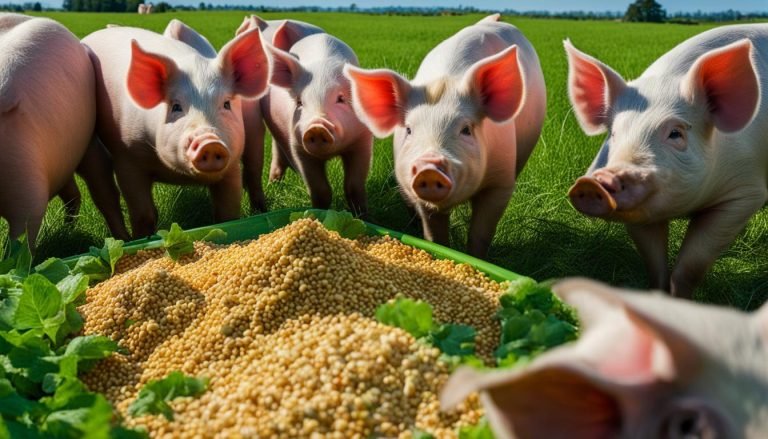What Do Fish Eat? Learn Their Diet
As aquatic animals, fish have a unique diet that can vary greatly depending on their species and environment.
Understanding what they eat is crucial to providing them with proper nutrition and ensuring their overall health and wellness in captivity.
From their natural prey to the various types of fish food available, let’s delve into the fascinating world of fish diets and uncover what exactly fish eat.
Key Takeaways:
- Fish have specific dietary requirements to maintain optimal health
- Their feeding patterns can include herbivorous, carnivorous, and omnivorous diets
- Various types of fish food are available including flakes, pellets, and live food
- A fish’s natural diet is important and can impact their overall health and wellness
- Feeding frequency, portion sizes, and observing feeding behaviors are essential for providing proper nutrition for fish
Fish Quiz
How well do you know fish? Test your knowledge here!
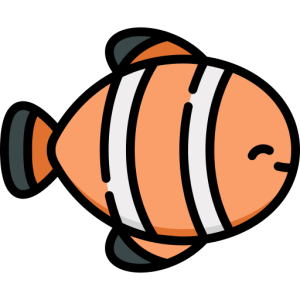
Understanding Fish Feeding Patterns

When it comes to feeding habits, fish are incredibly diverse. Some species are herbivores, consuming only plant matter, while others are carnivores and prey on other fish, invertebrates, or even small mammals. Some fish follow an omnivorous diet, consuming both plant and animal matter.
Understanding a fish’s feeding pattern is important when choosing the right diet. Some species may require a specific type of food, while others can be more flexible. Feeding patterns can also vary based on the fish’s age, size, and natural habitat.
For example, bottom-dwelling fish like catfish and loaches have a scavenging feeding pattern, sifting through the substrate for food. In contrast, mid-water fish like tetras and guppies have a primarily herbivorous or omnivorous diet, feeding on both plant and animal matter found in the water column. Predatory fish like cichlids and angelfish have a carnivorous diet, preying on smaller fish or invertebrates.
It’s important to note that some fish species may display multiple feeding patterns, depending on their environment. For example, some herbivorous fish may consume small invertebrates, while some carnivorous fish may supplement their diet with algae or plant matter.
“Understanding a fish’s feeding pattern is important when choosing the right diet.”
By understanding a fish’s feeding pattern, we can provide them with a balanced and nutritious diet that meets their specific needs. In the next section, we’ll explore different types of food available for fish and how they cater to different feeding patterns.
Types of Food for Fish

When it comes to feeding our aquatic friends, there are multiple types of food available. Choosing the right one depends on various factors, including fish species, nutritional requirements, and feeding habits. Let’s take a closer look at the different types of food for fish:
| Type of Food | Description | Examples |
|---|---|---|
| Flakes | Compressed flakes of food that typically float on the surface of the water. | TetraMin, Hikari Bio-Pure, Omega One |
| Pellets | Small, cylindrical or spherical food particles that usually sink to the bottom of the tank. | New Life Spectrum, Northfin, Aqueon |
| Live Food | Organisms that are alive and can provide an added level of enrichment for fish. | Brine shrimp, daphnia, bloodworms |
| Freeze-Dried Food | Food that has been preserved by freeze-drying and can provide a convenient alternative to live food. | Tubifex worms, krill, plankton |
It’s important to note that different fish species may require specific types of food. For example, carnivorous fish require a diet high in protein, while herbivorous fish need more vegetation-based food.
It’s also crucial to consider the nutritional value of the food you’re providing. A balanced diet for fish should include protein, fats, carbohydrates, vitamins, and minerals.
Lastly, it’s important to take into account the feeding habits of your fish. Some fish species are surface feeders and require food that floats, while others are bottom dwellers and need food that sinks.
Exploring a Fish’s Natural Diet
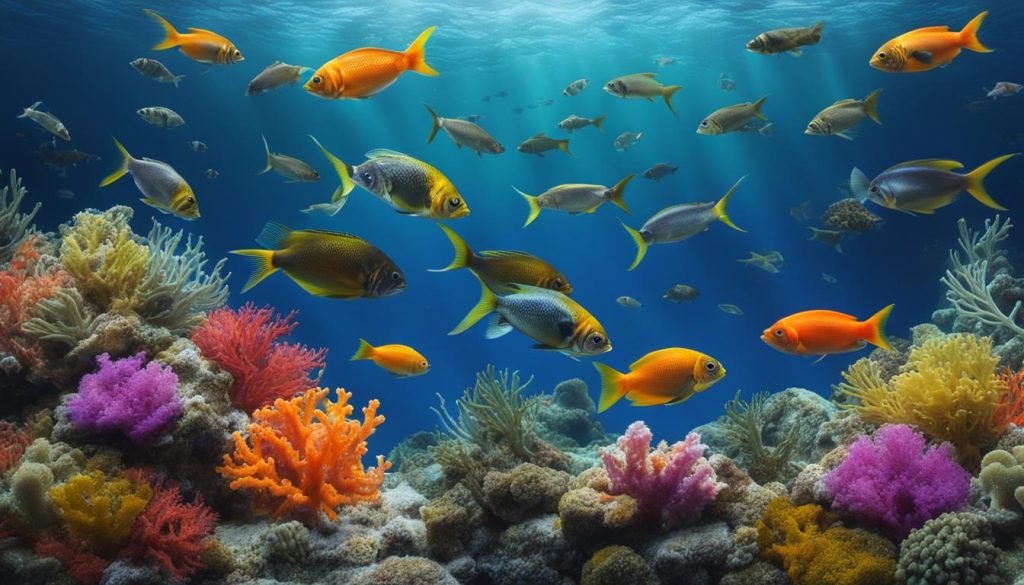
One of the most critical aspects of fish nutrition is understanding a fish’s natural diet. In the wild, fish consume a variety of organisms found in their natural habitat, including plants, insects, and other aquatic animals.
For example, herbivorous fish, such as goldfish and plecos, primarily feed on plants, while carnivorous fish, such as bettas and cichlids, consume other fish or invertebrates. Omnivorous fish, such as guppies and tetras, eat both plants and animals.
Feeding fish a diet that mimics their natural diet is crucial for their overall health and well-being in captivity. Providing appropriate food helps prevent the onset of diseases that result from poor nutrition.
For example, if you have herbivorous fish, providing them with a diet containing plenty of vegetables and plants, such as spinach or algae wafers, is vital. These foods provide essential nutrients, including fiber and vitamins, that they would typically consume in the wild.
On the other hand, carnivorous fish require plenty of protein-rich foods, such as live or frozen bloodworms or brine shrimp, to meet their nutritional needs. Without the appropriate diet, they may become lethargic, lose their color, or develop diseases such as fatty liver disease.
Understanding the natural diet of your fish species is essential for crafting a well-balanced diet that provides all the necessary nutrients to maintain good health. Consult with a veterinarian or an experienced fish keeper to understand what foods are appropriate for your fish species.
Understanding the Nutritional Needs of Fish

Just like any other living organism, fish have specific nutritional needs to maintain optimal health. It’s essential to provide them with a balanced diet that meets their requirements for protein, fats, carbohydrates, vitamins, and minerals.
When considering a fish’s diet, it’s important to take into account their natural habitat and feeding patterns. For instance, carnivorous fish require a protein-rich diet, while herbivorous fish thrive on a diet high in plant matter.
A well-rounded fish diet should consist of:
- Protein: Essential for growth and tissue repair, fish require protein from sources such as shrimp, worms, and krill.
- Fats: Provide energy and aid in the absorption of vitamins. Fish should receive healthy fats from sources such as fish oil or algae.
- Carbohydrates: While fish don’t require carbohydrates like humans do, they can benefit from small amounts of complex carbohydrates from vegetables or grains.
- Vitamins and minerals: Crucial for overall health and immune function, fish require a mix of vitamins and minerals from their diet. Supplements may be necessary if their diet is lacking in certain nutrients.
It’s important to note that different fish species have varying nutritional needs. For example, some fish require a higher percentage of protein in their diet, while others may require more vitamins or minerals.
When selecting fish food, be sure to read the label and assess the nutritional content. A high-quality fish food should provide the essential nutrients your fish need to thrive.
Did you know? Some fish, such as betta fish, are prone to overeating. It’s essential to monitor their feeding habits and portion sizes to prevent obesity and other health issues.
The Best Food for Fish
Choosing the best food for your fish can be a daunting task, but it’s crucial for their health and vitality. As I mentioned earlier, different fish species have varying dietary needs, which means there’s no one-size-fits-all solution when it comes to feeding. Therefore, it’s essential to understand your fish’s nutritional requirements and feeding habits before selecting their diet.
When shopping for fish food, it’s essential to choose high-quality, reputable brands that provide a balanced mix of nutrients. Look for labels that indicate the food is specifically formulated for your fish species to ensure you meet their unique needs.
Flake food is the most common type of fish food and is suitable for most aquarium fish. It’s easy to use and doesn’t contaminate the water, making it a low-maintenance option.
Pellets are another popular option as they provide a more balanced meal than flakes. They come in various sizes and sinking or floating forms, catering to different fish species’ feeding habits.
Pro Tip: If your fish prefer sinking food, place it in the tank at feeding time and remove any leftovers after a few minutes to prevent contamination and ensure the water remains clear.
Live food can be an excellent supplement to a fish’s diet, providing enrichment and mimicking their natural hunting instincts. However, it’s essential to choose safe, healthy live food options, such as brine shrimp, bloodworms, or daphnia, and avoid wild-caught organisms that may carry disease.
It’s also crucial to consider the overall nutrient balance of your fish’s diet. Fish need a mix of protein, fats, carbohydrates, vitamins, and minerals to maintain optimal health. Therefore, it’s vital to vary their diet and not rely on one type of food exclusively.
| Food Type | Benefits |
|---|---|
| Flake Food | – Easy to use and low-maintenance – Suitable for most aquarium fish |
| Pellets | – Provides a balanced mix of nutrients – Available in different sizes and floating or sinking forms |
| Live Food | – Mimics natural hunting instincts of fish – Provides enrichment |
By understanding your fish’s nutritional needs and feeding patterns, you can choose the best food for their overall well-being. Remember to vary their diet, supplement with live food if appropriate, and maintain a balanced nutrient mix. By doing so, you’ll ensure your fish thrive in their underwater home.
Factors Affecting Fish Feeding
Feeding fish is not as simple as just tossing in some food and calling it a day. Several factors can affect a fish’s feeding habits, including water temperature, water quality, tank size, and social interactions.
Water temperature plays a critical role in a fish’s metabolism and digestion. Different types of fish have different temperature requirements for optimal health and feeding. For example, tropical fish typically require warmer water temperatures than cold-water fish. It’s essential to research the specific temperature preferences of your fish and adjust your tank’s temperature accordingly.
Water quality is another significant factor in fish feeding. Poor water quality can lead to stress and illness, making it challenging for fish to eat. It’s crucial to maintain proper filtration, perform regular water changes, and test your water parameters to ensure a healthy environment for your fish to thrive.
The size of your tank can also impact feeding behaviors. Overcrowded tanks can lead to competition for food and stress among fish, while spacious tanks can provide ample swimming room and a more relaxed environment for feeding.
Social interactions between fish can also affect feeding patterns. Dominant fish may eat more aggressively and take a larger share of the food, while shy or timid fish may struggle to get enough to eat. It’s essential to observe your fish’s behavior during feeding time and ensure all fish are receiving enough food to meet their nutritional needs.
Table: Impact of Factors on Fish Feeding Habits
| Factors | Impact on Feeding Habits |
|---|---|
| Water Temperature | Different types of fish have varying temperature preferences for optimal feeding and digestion. |
| Water Quality | Poor water quality can lead to stress and illness, making it challenging for fish to eat. |
| Tank Size | Overcrowded tanks can lead to competition for food and stress among fish, while spacious tanks can provide ample swimming room and a more relaxed environment for feeding. |
| Social Interactions | Dominant fish may eat more aggressively and take a larger share of the food. Shy or timid fish may struggle to get enough to eat. |
By considering these factors, you can create a healthy and comfortable feeding environment for your fish. Observing your fish’s feeding behaviors and making adjustments as needed can help ensure they receive the proper nutrition for optimal health and well-being.
Feeding Tips for Healthy Fish
Feeding your fish is one of the most crucial aspects of their care routine. Here are some tips to ensure your aquatic friends receive the proper nutrition they need:
- Feed appropriate portions: Overfeeding can lead to health problems, such as obesity and digestive issues. A general rule of thumb is to feed a small amount, no more than what they can consume in two minutes, two to three times a day.
- Observe feeding habits: Pay attention to how your fish are eating. If they’re not finishing their food or seem uninterested, adjust the portion size and feeding frequency accordingly.
- Vary their diet: Providing a balanced diet is essential for your fish’s health and growth. Mix up their food options by incorporating different types of fish food or live food.
- Consider their feeding patterns: Certain fish have specific feeding patterns, such as being more active during certain times of the day. Knowing your fish’s habits can help you better accommodate their feeding needs.
- Use a feeding ring: If you have multiple fish, a feeding ring can help ensure each fish gets their fair share of food.
By following these tips, you’ll be well on your way to providing your fish with a healthy and nutritious diet!
Avoid These Common Feeding Mistakes
While it’s essential to feed your fish properly, it’s also crucial to avoid these common feeding mistakes:
- Feeding low-quality food: Not all fish food is created equal. Invest in high-quality food to ensure your fish receive the necessary nutrients for optimal health.
- Feeding too much: Overfeeding can lead to health problems in fish, as mentioned earlier.
- Feeding the wrong type of food: Different fish species have varying dietary needs. Make sure to research what your fish species need and adjust their diet accordingly.
- Feeding a monotonous diet: Providing the same type of food every day can lead to nutrient deficiencies. Mix up your fish’s diet to ensure they receive a balanced and nutritious meal.
By avoiding these mistakes and following the feeding tips listed above, you’ll be on your way to successfully nourishing your fish for a happy, healthy life.
Adjusting Diet for Different Fish Species
When it comes to feeding fish, it’s important to understand that different species have different dietary requirements. As an aquarium owner, it’s essential to tailor your fish’s feeding regimen to meet their specific needs. In this section, I will highlight some popular aquarium fish species and discuss their dietary needs.
| Fish Species | Diet Type | Recommended Food |
|---|---|---|
| Tetras | Omnivore | Small pellets, flakes, and frozen food |
| Betta Fish | Carnivore | Freeze-dried or live food such as bloodworms and brine shrimp |
| Goldfish | Omnivore | Pellets or flakes with added vegetables or algae |
| Cichlids | Omnivore/Carnivore | Pellets or flakes with added vegetables, frozen or live food such as krill, brine shrimp, and bloodworms |
As you can see, different fish species have varying dietary needs. It’s crucial to research the dietary requirements of your particular fish species to ensure they receive the necessary nutrients for optimal health. If you’re unsure what your fish should be eating, consult with a knowledgeable pet store employee or veterinarian who can provide guidance.
In the next section, we’ll explore the benefits of supplementing fish diets with live food.
Supplementing Fish Diet with Live Food
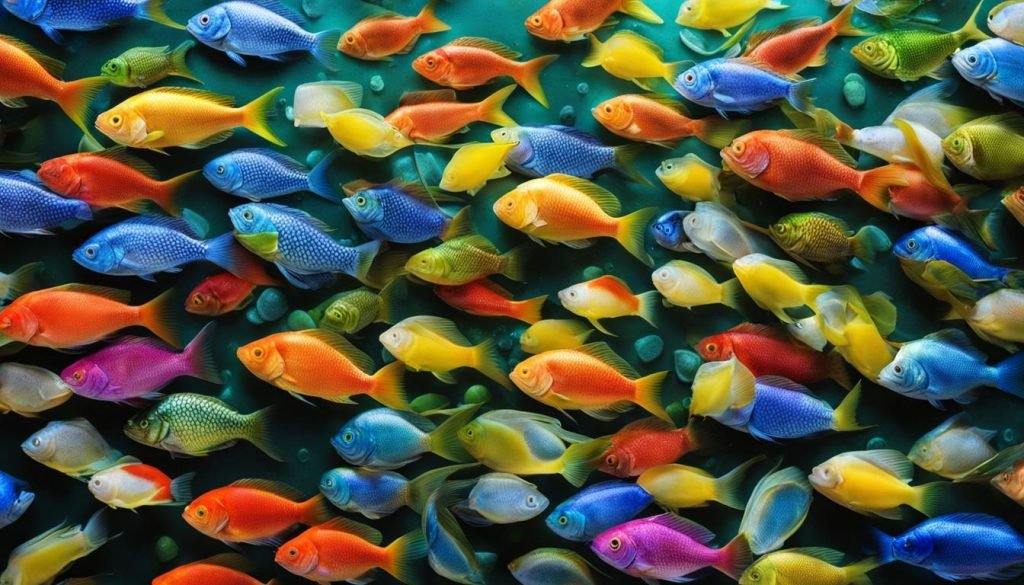
Live food can be a great addition to your fish’s diet. Not only does it provide variety, but it can also mimic their natural hunting instincts and provide enrichment. However, it’s important to choose the right live food and supplement it appropriately.
Some common live food options include:
- Daphnia: Small freshwater crustaceans that are high in protein and minerals.
- Brine shrimp: Small, shrimp-like creatures that are also high in protein and can help with digestion.
- Worms: Live or frozen worms such as bloodworms or earthworms can provide essential fatty acids and vitamins.
It’s important to note that live food should only be a supplement to your fish’s regular diet, not a replacement. Overfeeding live food can lead to digestive issues and water quality problems.
When supplementing with live food, it’s also important to consider the size and feeding habits of your fish. For example, small- to medium-sized fish may benefit from smaller live food options such as Daphnia or brine shrimp, while larger carnivorous fish may prefer larger live food such as worms or feeder fish.
Additionally, it’s important to properly prepare live food before feeding it to your fish. This can include rinsing it thoroughly to remove any unwanted debris or bacteria or freezing it for later use.
Supplementing your fish’s diet with live food can provide numerous benefits, but it’s important to do so in moderation and with consideration for your fish’s specific nutritional needs and feeding habits.
Overcoming Feeding Challenges
When it comes to feeding fish, various challenges may arise. Some fish may exhibit picky eating habits, while others may refuse to eat certain types of food altogether. As responsible fish owners, it’s essential to find solutions to these feeding challenges and ensure our aquatic friends receive proper nutrition.
Strategy 1: Introduce New Foods Gradually
Some fish may be hesitant to eat new types of food, especially if they’re used to a specific diet. To overcome this challenge, I recommend introducing new foods gradually. Start by introducing a small amount of the new food alongside their regular diet. Over time, you can increase the portion size of the new food and gradually decrease their old diet until they’re eating the new food entirely. This approach allows your fish to adjust to the new flavor and texture of the food while still receiving proper nutrition.
Strategy 2: Offer a Variety of Foods
Just like people, fish can get bored with the same food every day. Providing a variety of foods can help keep your fish interested in eating. Offer different types of food, such as flakes, pellets, and live food, and rotate them throughout the week. This approach can also ensure your fish receive a balanced diet and all the essential nutrients they need.
Strategy 3: Consider Feeding Times and Amounts
Feeding times and amounts can significantly impact a fish’s appetite and eating habits. Overfeeding can lead to obesity and other health issues, while underfeeding can cause malnutrition. I recommend feeding your fish in small amounts two to three times a day, depending on their species and dietary needs. Observe their eating habits and adjust the portion sizes accordingly to ensure they’re receiving an appropriate amount of food.
Strategy 4: Make Sure the Water Quality is Adequate
Poor water quality can also affect a fish’s appetite and eating habits. If the water is too dirty, cloudy, or has high ammonia or nitrate levels, your fish may become stressed and refuse to eat. It’s essential to maintain proper water quality through regular water changes, filter maintenance, and testing to ensure your fish are in a healthy and stress-free environment.
By implementing these strategies, you can overcome feeding challenges and ensure your fish receive proper nutrition. A balanced and varied diet can help keep your fish healthy and happy, and observing their feeding behaviors can help you determine if any adjustments to their diet are necessary.
Conclusion: Nourishing Our Aquatic Friends
As I conclude this article, I hope you’ve gained a better understanding of fish diets, feeding patterns, and nutritional requirements. Providing a balanced diet is essential for ensuring our fish friends remain healthy and happy in captivity.
Fish Food Choices Matter
When deciding on the best food for your fish, there are several factors to consider. The type of fish you have, their feeding habits, and any specific nutritional needs they may have should guide your selection of fish food.
Nutrition is Key
Protein, fats, carbohydrates, vitamins, and minerals all play a crucial role in maintaining healthy fish. By selecting a high-quality fish food that provides these essential nutrients, you can ensure your fish remain healthy and thrive in their underwater habitat.
Observing Feeding Behaviors
Regular observation of your fish’s feeding habits can provide critical insight into their health and well-being. By monitoring their appetite, feeding frequency, and portion sizes, you can fine-tune their feeding routine to meet their specific nutritional needs.
Catering to Different Fish Species
Understanding the dietary requirements of your fish species is crucial for tailoring their feeding regimen correctly. Some fish may require live food supplements, while others may prefer pellets or flakes. By catering to their specific dietary needs, you can ensure they receive the optimal nutrition for their optimal health.
Overcoming Feeding Challenges
As with any pet, feeding challenges may arise in some fish species. By offering different types of food, adjusting feeding times, and monitoring feeding habits, you can help encourage healthy eating behaviors and ensure your fish receive the nutrition they need to thrive.
In conclusion, by providing a balanced and nutritious diet, observing feeding behaviors, and catering to their dietary needs, we can cultivate healthy and happy fish friends in our aquariums. I hope this article proved useful and informative in helping you nourish your aquatic companions.
More About Fish:
- How Do Fish Mate? – Fish Mating Process
- How Long Do Fish Live: Average Lifespan of Fish
- 15 Facts About Fish You Didn’t Know
- Fish Quiz: How Well Do You Know Fish?
Frequently Asked Questions
What do fish eat?
Fish eat a variety of foods, including algae, plants, insects, smaller fish, and crustaceans.
What are the different feeding patterns of fish?
Fish have different feeding patterns, such as herbivorous (eating plants), carnivorous (eating other animals), and omnivorous (eating both plants and animals).
What types of food are available for fish?
There are various types of fish food, including flakes, pellets, live food, and freeze-dried options. Each type has its own benefits and considerations.
Why is it important to understand a fish’s natural diet?
Understanding a fish’s natural diet is important because it allows us to provide them with the proper nutrients and replicate their natural feeding habits in captivity.
What are the nutritional needs of fish?
Fish require essential nutrients such as protein, fats, carbohydrates, vitamins, and minerals to maintain optimal health.
What is the best food for fish?
The best fish food depends on the species and their nutritional needs. There are many high-quality options available on the market to cater to different fish species.
What factors can affect fish feeding?
Factors such as water temperature, water quality, tank size, and social interactions can influence a fish’s appetite and eating habits.
What are some feeding tips for healthy fish?
To ensure healthy fish, it’s important to observe feeding behaviors, feed them the appropriate portion sizes, and provide a balanced diet.
How should I adjust the diet for different fish species?
Different fish species have varying dietary requirements. It’s important to research their specific diet needs and tailor their feeding regimen accordingly.
Can I supplement a fish’s diet with live food?
Yes, live food can be a beneficial addition to a fish’s diet as it provides enrichment and stimulates their natural hunting instincts. However, it should be done safely and in moderation.
How can I overcome feeding challenges with my fish?
If your fish has finicky eating habits or refuses certain types of food, you can try introducing variety, adjusting feeding methods, or consulting with an expert for advice.
Why is proper nutrition important for fish?
Providing proper nutrition is crucial for maintaining the overall health and well-being of fish, ensuring they live long and thrive in their aquatic environment.

